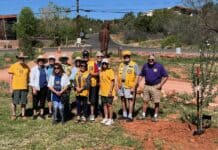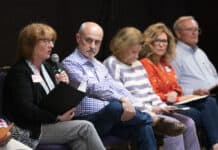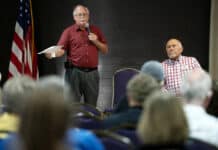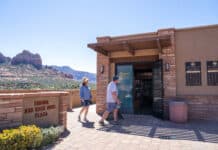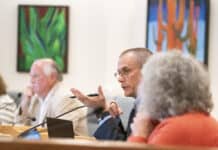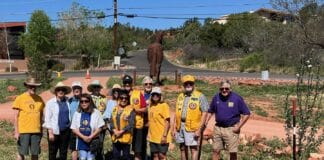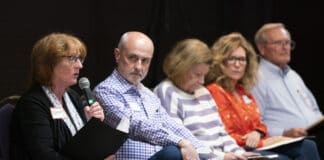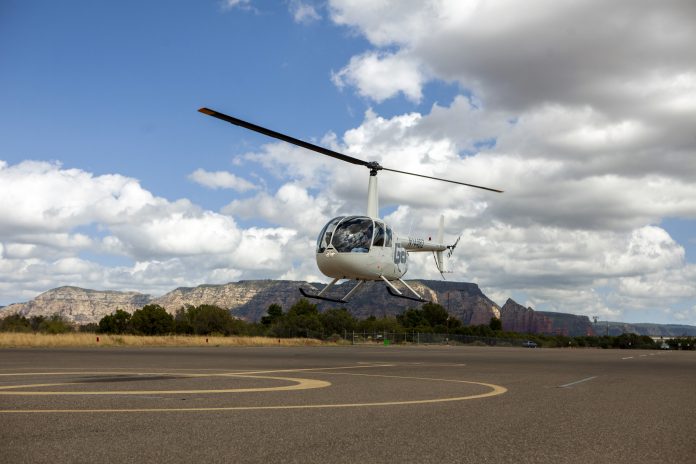
Sedona City Manager Justin Clifton doubted he’d ever see such an agreement.
Following nearly two years of discussion and negotiations, Sedona’s two helicopter tour companies reached an agreement to establish a no-fly zone over the vast majority of the city.
“It’s a testament to persistence and willingness,” Clifton said. “So to the tour operators, thank you for doing the right thing.”
In addition to the city and the two tour operators — Guidance Air and Sedona Air Tours — Yavapai County, Sedona -Oak Creek Airport Authority, Keep Sedona Beautiful and the Sedona Chamber of Commerce all had a hand in this agreement.
Several years ago, a city-initiated work group looked at noise mitigation in regard to helicopter tours at the airport, but the initiative failed to gain traction. Members had several ideas, some of which Clifton said were realistic and others not so much — like relocating the airport or putting a quota on the number of flights allowed. When Clifton was hired five years ago, he decided to see what could be done.
“The bottom line is, the FAA [Federal Aviation Administration] is pretty touchy about regulating airspace,” he said. “They have sole jurisdiction over it. It makes things more complicated that the airport is an individual entity — a 501(c) — occupying land owned by the county. It’s also surrounded by land owned by the U.S. Forest Service and located in the center of a town. There are layers and layers or jurisdictions.”
Clifton said for years they were stuck as they tried to find a solution. But then the Sustainable Tourism Plan — a joint venture between the chamber and city — was born and it occurred to him what they needed to do was to strike a balance between quality of life and a healthy economy.
The city did its own sound testing in five locations around town, going on the premise that flying 2,000 above ground was the minimum threshold to help prevent noise below. The chamber paid to have a pilot fly 500 feet above ground, then 1,000 feet and finally 1,500. It then tested what would happen if instead of 1,500 feet above them, the pilot was 1,500 feet away from them at a lower altitude.
“What we learned was, basically, that distance is distance,” he said. “If they are 1,500 feet away sideways or laterally, it’s the same as if they are 1,500 feet above.”
Clifton said the tour companies offer trips in which visitors see a handful of local sites often in less than 15 minutes. But in interest of saving time, the route would often take them directly over populated areas of the city. He said if a plan was to work in which the companies would take an alternative route, both tour providers would have to be on board to avoid giving a competitive edge to one and not the other.
Both companies agreed to take off and arrive on the south end of the airport, which avoids flying over nearly all the homes in the area.
“The result is a no-fly zone,” Clifton said. “If you look at the map, you can see it includes almost the entire city with the exception of right where they take off and land on the south end of the airport. And even for the few homes in that area, they will still be at least 1,500 feet away.”
Other key points in the agreement include:
— Regular tour flights will occur only between 8 a.m. and dusk.
— Flight paths and altitudes will be electronically documented and archived and will be made available to the city. A protocol for noise complaints will be at SedonaAirNoise.com.
— Operators will not hover over or near sensitive archeological sites at any time during tour operations.
— Operators will be sensitive to the impact of noise on neighborhoods and heritage sites such as ruins and areas sacred to indigenous peoples.
“The reason I think this is so special is because you look at communities from Hawaii to California to the northeast and almost nobody has been able to accomplish this kind of mitigation,” Clifton said. “Most are trying to do it forcefully by compelling the FAA to agree to new regulations.
“We got something meaningful done through cooperation and through a non-traditional partner like the chamber of commerce. Everyone at the table said that we want to find a better balance between higher quality of life and a stronger economy. We came together and worked through something that I truly thought had a slim chance of happening.”
This agreement with the tour companies is voluntary and thus did not require the FAA’s blessing.
“By working together, we are permanently reducing helicopter noise in Sedona and throughout red rock country, effective immediately,” Chamber President and CEO Jennifer Wesselhoff said in a press release.
“Natural quiet is a fragile asset that is crucial to Sedona’s quality of life, the experience we offer visitors and our environmental sustainability. Sedona Air Tours and Guidance Air are respected businesses and excellent community partners. We are delighted with their commitment to noise reduction.”


